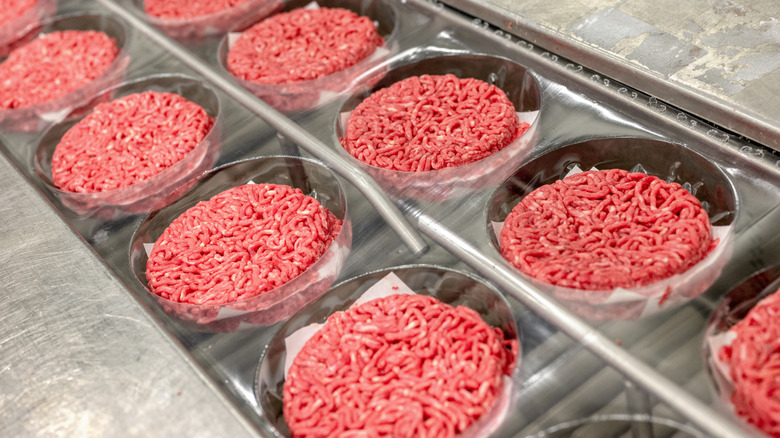Now, as you head down the meat aisle, you should have a basic understanding of what constitutes processed red meat. Fresh steaks, lamb roasts, and pork tenderloin are all in the clear. But that pâté or pastrami? Not so much. And ultimately, this distinction matters because these two types of meat can affect your health differently, and the degree to which meat is processed also impacts its nutritional value.
What Does It Mean When Red Meat Is Processed?

Nordroden/Shutterstock
Red meat obviously needs some level of slicing and packaging to reach store shelves. However, this doesn't immediately fall under the definition of processed meat because it's not necessarily being altered from its original state. Meanwhile, frozen or ground meat technically undergoes processing, but it's solely mechanical processing that doesn't change the meat's nutritional content. So while it leaves some room for debate, we wouldn't call it processed meat either. What happens after the beef is minced is another story. Burger patties on their own are simply ground beef, but if you buy a prepackaged version with preservatives and chemical flavorings, it would fall under the WHO's definition of 'processed.'
Since the USDA considers pork a red meat, ham is red meat as well. Fresh ham is pork leg that hasn't been cured, salted, or smoked, meaning it wouldn't be considered processed. But all those smoked or salted luncheon meats definitely would. Cured meats are also a type of processed meat, and include everything from prosciutto to pepperoni. Truthfully, processed ham is far more ubiquitous than the fresh stuff. If you're looking for unprocessed pork, the safest bet is fresh, raw cuts straight from the butcher.

Fcafotodigital/Getty Images
Processed foods — including red meat — have a bad rap. But is it warranted? In short, yes. Red meat itself is a nutrient-dense food, providing essential proteins, iron, zinc, and B vitamins. As such, unprocessed red meat can be part of a healthy diet when consumed in moderation. However, the processing of red meat introduces some concerning elements.
The preservatives used, including nitrates and nitrites, can potentially form harmful compounds called nitrosamines when exposed to high heat during cooking. To put this in perspective, the CDC considers nitrates and nitrites "probably carcinogenic," but classifies nitrosamines as a known carcinogen. Plus, processed meats often contain more sodium than their unprocessed counterparts. And according to the Harvard T.H. Chan School of Public Health, processed red meat is linked to increased risk of cancer, heart disease, and diabetes.
Luckily, health-conscious consumers are catching on, which has prompted manufacturers to turn to more natural preservation methods. The difference between uncured and cured packaged meat often comes down to the quality of the ingredients used, and whether they are natural or synthetic. Read the label to identify any questionable ingredients so you can make an educated decision. And if you're trying to eat healthy, fresh red meat is ultimately the better option since you can enjoy all the nutritional benefits and flavor without the added chemicals or excess salt.












